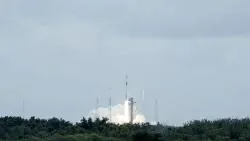
Europe's Hera Asteroid Probe Takes Off Aiming for a Cosmic Mission!
2024-10-08
Author: Arjun
Launch of Europe's Hera Asteroid Probe
In an exciting leap for planetary defense, Europe's Hera asteroid probe successfully launched from Florida aboard a SpaceX Falcon 9 rocket on Monday. This groundbreaking mission kicks off a two-year journey to the Dimorphos asteroid, a celestial body that was recently nudged off course by NASA's historic Double Asteroid Redirection Test (DART) in 2022.
Importance of the Hera Mission
This follow-up mission is a pivotal step in understanding how we might protect Earth from potential asteroid threats. By studying the effects of DART's collision, scientists aim to discover whether similar techniques could be employed should a hazardous asteroid be on a collision course with our planet.
Launch Details
The Falcon 9 rocket lifted off at approximately 3 p.m. GMT, with thousands tuning in to watch the live launch broadcast. The European Space Agency (ESA) strategically chose SpaceX for this endeavor, filling a crucial gap in Europe’s own access to space.
About Dimorphos and the DART Mission
Dimorphos is a small moonlet orbiting the near-Earth asteroid Didymos. The DART mission, launched in 2021, was the first of its kind to intentionally collide with an asteroid at around 22,530 kilometers per hour. This collision occurred on September 26, 2022, approximately 11 million kilometers away from Earth, leading to significant changes in the asteroid's trajectory and even its shape, as revealed by scientists in March.
Hera's Role in Planetary Defense
Constructed by Germany's OHB SE, Hera is set to conduct a comprehensive survey of Dimorphos post-impact. This experimentation is crucial for developing a reliable strategy for planetary defense, expanding on the knowledge gained from the DART mission.
The Asteroid Challenge
The universe holds a staggering number of asteroids—over half a million within our solar system, with more than 25,000 categorized as near-Earth objects. Notably, ESA’s risk list highlights over 1,000 of these asteroids requiring ongoing observation due to their potential threat to Earth.
Conclusion
In a world increasingly aware of the vulnerabilities posed by space debris, the launch of Hera is not just a scientific endeavor; it’s a significant stride towards the protection of our planet against cosmic threats. What does the future hold for planetary defense? Stay tuned as ESA and NASA lead the charge into uncharted space!


 Brasil (PT)
Brasil (PT)
 Canada (EN)
Canada (EN)
 Chile (ES)
Chile (ES)
 España (ES)
España (ES)
 France (FR)
France (FR)
 Hong Kong (EN)
Hong Kong (EN)
 Italia (IT)
Italia (IT)
 日本 (JA)
日本 (JA)
 Magyarország (HU)
Magyarország (HU)
 Norge (NO)
Norge (NO)
 Polska (PL)
Polska (PL)
 Schweiz (DE)
Schweiz (DE)
 Singapore (EN)
Singapore (EN)
 Sverige (SV)
Sverige (SV)
 Suomi (FI)
Suomi (FI)
 Türkiye (TR)
Türkiye (TR)